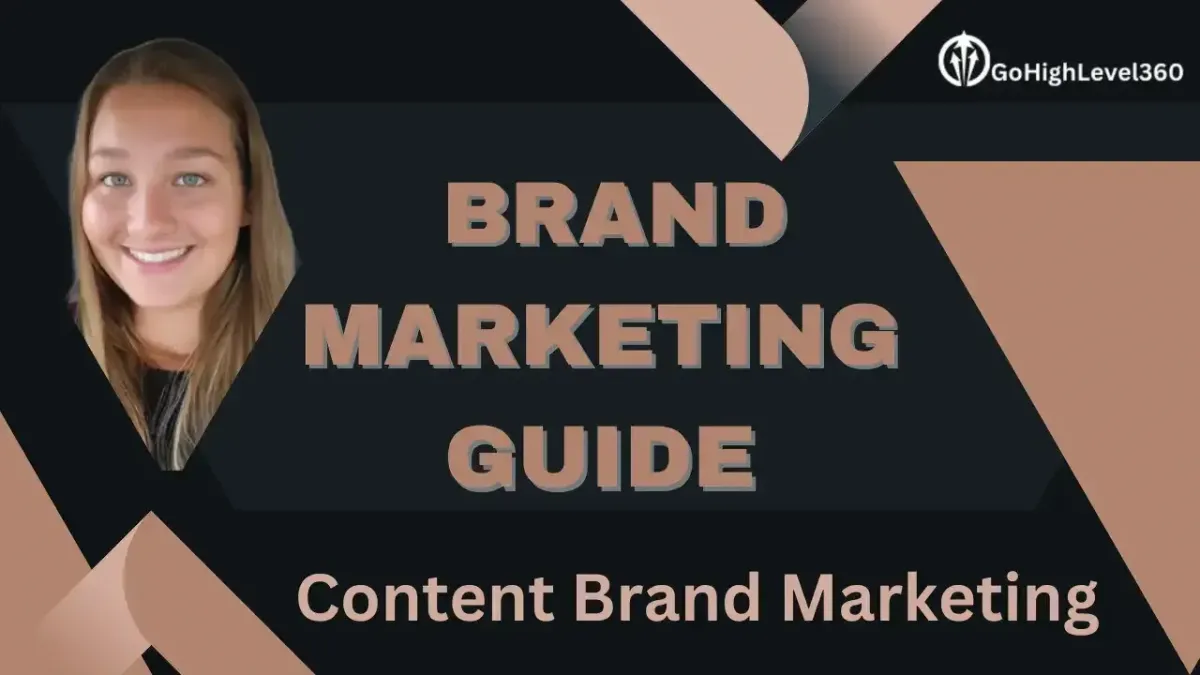"Leadership is the art of giving people a platform for spreading ideas that work." – Seth Godin
Go High Level 360 Content Brand Marketing

Content Brand Marketing
Table of Contents:
1. Introduction to Brand Content Marketing
Brand content marketing involves creating and sharing valuable, relevant, and consistent content to attract and engage a clearly defined audience.
Seth Godin highlights the significance of permission marketing, where consumers voluntarily engage with your content because it offers real value.
Content marketing aims to build trust, authority, and loyalty by providing information and stories that resonate with the audience.
This approach shifts the focus from direct selling to creating meaningful connections with your audience through valuable content.
2. Importance of Content Marketing
Effective content marketing helps to:
Build Brand Awareness and Recognition: By consistently publishing valuable content, you increase your brand's visibility and familiarity among your target audience.
Establish Thought Leadership and Authority: Sharing insightful and expert content positions your brand as a leader in your industry, enhancing credibility.
Foster Customer Loyalty and Trust: Providing useful and relevant content helps build trust and loyalty among your audience, encouraging repeat engagement.
Drive Traffic and Generate Leads: Quality content attracts visitors to your website, where you can convert them into leads through calls-to-action and lead magnets.
Improve SEO and Search Engine Rankings: Regularly updated content that addresses audience queries and uses relevant keywords can boost your search engine rankings.
Engage and Educate the Audience: Content marketing provides an opportunity to engage your audience with informative and entertaining content, keeping them coming back for more.
3. Steps to Develop a Content Marketing Strategy
Define Your Goals: Determine what you want to achieve with your content marketing efforts (e.g., brand awareness, lead generation). Clear goals guide your strategy and help measure success.
Understand Your Audience: Conduct audience analysis to understand their needs, preferences, and pain points. Knowing your audience ensures that your content is relevant and engaging.
Create a Content Plan: Outline the types of content you will create, topics to cover, and the channels you will use for distribution. A well-thought-out plan ensures consistent and targeted content creation.
Develop a Content Calendar: Plan your content creation and distribution schedule to ensure consistency. A calendar helps in organizing your efforts and maintaining a steady flow of content.
Create High-Quality Content: Focus on producing valuable, relevant, and engaging content that addresses your audience’s needs. High-quality content resonates more and builds trust.
Distribute Your Content: Share your content across appropriate channels to reach your target audience. Tailor your content for each channel to maximize reach and engagement.
Measure and Optimize: Track the performance of your content and make adjustments based on data and feedback. Continuous improvement ensures your strategy remains effective.
4. Types of Content for Brand Marketing
Blog Posts: In-depth articles that provide valuable information and insights. Blogs help in SEO and establishing authority.
Videos: Engaging and shareable content that can include tutorials, interviews, and behind-the-scenes looks. Videos are highly effective for storytelling and capturing attention.
Infographics: Visual representations of data and information that are easy to understand and share. Infographics simplify complex information and enhance shareability.
Ebooks and Whitepapers: Comprehensive guides and reports that provide in-depth knowledge on specific topics. These are excellent for lead generation and demonstrating expertise.
Social Media Posts: Short, engaging content that encourages interaction and sharing. Social media helps in reaching a wider audience and fostering community engagement.
Podcasts: Audio content that offers valuable insights and stories related to your industry. Podcasts are convenient for on-the-go consumption and can build a loyal following.
Case Studies: Detailed accounts of how your product or service has helped customers achieve their goals. Case studies provide social proof and showcase real-world applications.
Email Newsletters: Regular updates and valuable content delivered directly to your audience’s inbox. Newsletters keep your audience informed and engaged with your brand.
5. Content Creation and Distribution
Content Creation:
Focus on producing high-quality content that aligns with your brand’s voice and values. Use a mix of text, images, videos, and interactive elements to keep your audience engaged. Invest in quality over quantity, ensuring each piece of content provides genuine value.
Content Distribution:
Utilize multiple channels such as your website, social media platforms, email marketing, and guest posting on relevant websites. Tailor your content for each channel to maximize reach and engagement. Effective distribution ensures that your content reaches the right audience at the right time.
6. Measuring Content Marketing Success
Key Metrics:
Track metrics such as website traffic, engagement (likes, shares, comments), lead generation, conversion rates, and SEO performance. These metrics help in assessing the effectiveness of your content.
Tools:
Use tools like Google Analytics, social media analytics, and email marketing platforms to measure and analyze the performance of your content. These tools provide valuable insights and help in optimizing your strategy.
Feedback:
Collect and analyze feedback from your audience to understand what content resonates most and where improvements can be made. Audience feedback is crucial for continuous improvement and ensuring your content remains relevant.
7. Case Studies of Successful Content Marketing
Go High Level: Known for its comprehensive and robust CRM that attract and engage its target audience. HubSpot’s content strategy focuses on providing value through actionable insights and expert advice.
Red Bull: Excels in creating high-energy, adventurous content that aligns with its brand identity. Red Bull’s content includes extreme sports videos, events, and lifestyle articles that engage its audience.
Coca-Cola: Engages audiences with storytelling and user-generated content campaigns. Coca-Cola’s content marketing emphasizes emotional connections and brand loyalty through compelling stories and experiences.
8. Common Challenges in Content Marketing
Content Saturation: Standing out in a crowded content landscape. Focus on creating unique and high-quality content that offers real value to your audience.
Maintaining Consistency: Producing high-quality content regularly. A content calendar and a dedicated team can help maintain consistency.
Measuring ROI: Quantifying the impact of content marketing efforts on business goals. Use a combination of metrics and attribution models to assess ROI.
Adapting to Trends: Keeping up with changing audience preferences and content trends. Stay informed about industry trends and be flexible in adapting your strategy.
9. Final Thoughts
Brand content marketing is essential for building strong, lasting relationships with your audience.
By creating and sharing valuable content that addresses the needs and interests of your audience, you can enhance brand loyalty, drive engagement, and achieve your marketing goals.
Effective content marketing requires a strategic approach, consistent execution, and continuous optimization based on data and feedback. Embrace the principles of permission marketing and focus on delivering value to create a meaningful impact.
10. FAQs
What is the difference between content marketing and traditional advertising?g?
Content marketing focuses on creating valuable content that attracts and engages the audience, while traditional advertising often involves direct promotional messages and sales tactics.
How often should I publish new content?
The frequency depends on your audience and resources. Consistency is key, whether you publish weekly, bi-weekly, or monthly.
Can small businesses benefit from content marketing?
Yes, content marketing can help small businesses build brand awareness, engage with their audience, and drive traffic without large advertising budgets.
What type of content is most effective?
The most effective content depends on your audience and goals. Generally, a mix of blog posts, videos, social media updates, and visual content tends to perform well.
How can I measure the success of my content marketing efforts?
Use key metrics such as website traffic, engagement, lead generation, and conversion rates. Tools like Google Analytics and social media analytics can help track and analyze these metrics.
